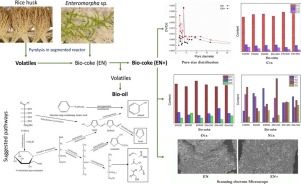当前位置:
X-MOL 学术
›
J. Anal. Appl. Pyrol.
›
论文详情
Our official English website, www.x-mol.net, welcomes your feedback! (Note: you will need to create a separate account there.)
Study on the interaction effect of seaweed bio-coke and rice husk volatiles during co-pyrolysis
Journal of Analytical and Applied Pyrolysis ( IF 6 ) Pub Date : 2018-06-01 , DOI: 10.1016/j.jaap.2018.03.009 Shuang Wang , Ding Jiang , Bin Cao , Yamin Hu , Chuan Yuan , Qian Wang , Zhixia He , Chi-Wai Hui , Abd El-Fatah Abomohra , Xinlin Liu , Yongqiang Feng , Bo Zhang
Journal of Analytical and Applied Pyrolysis ( IF 6 ) Pub Date : 2018-06-01 , DOI: 10.1016/j.jaap.2018.03.009 Shuang Wang , Ding Jiang , Bin Cao , Yamin Hu , Chuan Yuan , Qian Wang , Zhixia He , Chi-Wai Hui , Abd El-Fatah Abomohra , Xinlin Liu , Yongqiang Feng , Bo Zhang

|
Abstract Biomass is a wide-spread resource that have been studied for decades to realize energy utilization is a renewable and sustainable way. It was reported that there is a synergistic interaction during co-pyrolysis of different biomasses such as algae and terrestrial plants, but the mechanism is still unclear. This study aims to investigate the heterogeneous interactions between rice husk (HU) volatile and Enteromorpha clathrate (EN) bio-coke during co-pyrolysis using a sectional tubular pyrolysis furnace. Physical and chemical properties of the interacted bio-coke were studied using N2 isothermal absorption method, X-ray photoelectron spectroscopy (XPS), Fourier transform infrared spectroscopy (FTIR) and scanning electron microscopy (SEM). In addition, the obtained bio-oil was also characterized by gas chromatography-mass spectrometer (GC/MS). The changes in specific surface area of the pyrolyzed bio-coke indicated the significant effect of HU volatiles on EN bio-coke microstructure. After flew through by rice husk volatiles, the adsorption capacity of EN bio-coke improved. Owing to the free radicals in HU volatile, polycondensation and aromatization reactions were enhanced in EN bio-coke resulting in aromatic compounds with higher cyclization of nitrogenous compounds. On the other hand, EN bio-coke participated the decomposition of carbohydrates in HU volatiles to increase the content of aldehydes and furans in the produced bio-oil. In addition, the significant Maillard reaction accelerated the production of ketones and phenols in the bio-oil and reduced the content of N in EN bio-coke at 400 °C. The present study confirmed that there is a significant interaction between seaweed bio-coke and rice husk volatiles during co-pyrolysis.
中文翻译:

共热解过程中海藻生物焦与稻壳挥发物相互作用的研究
摘要 生物质是一种广泛存在的资源,几十年来一直在研究以实现能源利用是一种可再生和可持续的方式。据报道,藻类和陆生植物等不同生物质在共热解过程中存在协同作用,但机制尚不清楚。本研究旨在研究使用分段管式热解炉共热解过程中稻壳 (HU) 挥发物和浒苔包合物 (EN) 生物焦之间的异质相互作用。使用N2等温吸收法、X射线光电子能谱(XPS)、傅里叶变换红外光谱(FTIR)和扫描电子显微镜(SEM)研究了相互作用的生物焦的物理和化学性质。此外,获得的生物油还通过气相色谱-质谱仪(GC/MS)进行了表征。热解生物焦比表面积的变化表明 HU 挥发物对 EN 生物焦微观结构的显着影响。EN生物焦经过稻壳挥发物后的吸附能力提高。由于 HU 挥发物中的自由基,EN 生物焦中的缩聚和芳构化反应增强,导致芳香族化合物具有更高的含氮化合物环化。另一方面,EN生物焦参与了HU挥发物中碳水化合物的分解,以增加所生产的生物油中醛和呋喃的含量。此外,显着的美拉德反应加速了生物油中酮类和酚类的生成,并降低了 400 °C 时 EN 生物焦炭中 N 的含量。本研究证实,在共热解过程中,海藻生物焦和稻壳挥发物之间存在显着的相互作用。
更新日期:2018-06-01
中文翻译:

共热解过程中海藻生物焦与稻壳挥发物相互作用的研究
摘要 生物质是一种广泛存在的资源,几十年来一直在研究以实现能源利用是一种可再生和可持续的方式。据报道,藻类和陆生植物等不同生物质在共热解过程中存在协同作用,但机制尚不清楚。本研究旨在研究使用分段管式热解炉共热解过程中稻壳 (HU) 挥发物和浒苔包合物 (EN) 生物焦之间的异质相互作用。使用N2等温吸收法、X射线光电子能谱(XPS)、傅里叶变换红外光谱(FTIR)和扫描电子显微镜(SEM)研究了相互作用的生物焦的物理和化学性质。此外,获得的生物油还通过气相色谱-质谱仪(GC/MS)进行了表征。热解生物焦比表面积的变化表明 HU 挥发物对 EN 生物焦微观结构的显着影响。EN生物焦经过稻壳挥发物后的吸附能力提高。由于 HU 挥发物中的自由基,EN 生物焦中的缩聚和芳构化反应增强,导致芳香族化合物具有更高的含氮化合物环化。另一方面,EN生物焦参与了HU挥发物中碳水化合物的分解,以增加所生产的生物油中醛和呋喃的含量。此外,显着的美拉德反应加速了生物油中酮类和酚类的生成,并降低了 400 °C 时 EN 生物焦炭中 N 的含量。本研究证实,在共热解过程中,海藻生物焦和稻壳挥发物之间存在显着的相互作用。



























 京公网安备 11010802027423号
京公网安备 11010802027423号